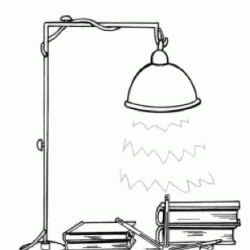Source Institutions
Source Institutions
Add to list Go to activity
Activity link broken? See if it's at the internet archive

This activity helps learners understand how the angle of the Sun affects temperatures around the globe. After experimenting with a heat lamp and thermometers at differing angles, learners apply what they learned to explain temperature variations on Earth. The printable six-page handout includes a series of inquiry-based questions to get learners thinking about what they already know about temperature patterns, detailed experiment directions, and a worksheet that helps learners use the experiment results to gain a deeper understanding of seasonal temperature changes and why Antarctica is always cold.
- Under 5 minutes
- 45 to 60 minutes
- $1 - $5 per group of students
- Ages 11 - 18
- Activity, Experiment/Lab Activity
- English
Quick Guide
Materials List (per group of students)
- 3 thermometers
- heat lamp
- flat surface
- scrap paper
- graph paper
- stopwatch
- books or other items to prop up thermometers
Subjects
-
Earth and Space Science
-
Earth Processes
- Weather and Climate
-
Earth, Moon and Sun
- Seasons
-
Solar System
- The Sun
-
Earth Processes
-
Life Sciences
-
Ecology
- Human Impact
-
Ecology
-
Mathematics
-
Data Analysis and Probability
- Data Analysis
- Data Collection
- Data Representation
-
Geometry
- Plane Geometry
-
Measurement
- Rate
-
Data Analysis and Probability
-
Physical Sciences
-
Heat and Thermodynamics
- Heat and Temperature
-
Vibration and Waves
- Light and Optics
-
Light and Optics
- Sunlight and Color
-
Heat and Thermodynamics
-
The Nature of Science
-
The Scientific Process
- Asking Questions
- Conducting Investigations
- Gathering Data
- Formulating Explanations
- Communicating Results
-
The Scientific Process
Informal Categories
- Nature and Environment
Audience
To use this activity, learners need to:
- see
- read
- touch
Learning styles supported:
- Involves teamwork and communication skills
- Involves hands-on or lab activities
Other
This resource is part of:
Access Rights:
- Free access
By:
Rights:
- All rights reserved, American Museum of Natural History and Rice University, 2002
